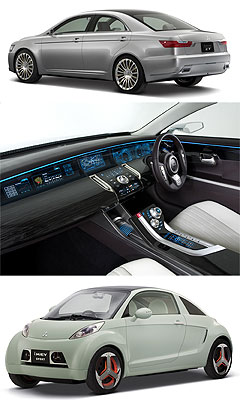Make / Model Search
Future models - Mitsubishi - GalantFirst look: ZT could be Mitsu 380 successorMajor Mitsu: Concept-ZT is narrower but almost 100mm longer than the 380. Mitsubishi's AWD turbo-diesel ZT concept could morph into a 380 successor11 Sep 2007 HERE is the car that could replace the Mitsubishi 380 in about 2011 – whether or not the company decides to keep building passenger cars in Australia. Called the Concept-ZT, it will be presented as a concept car at the Tokyo motor show late next month, but clearly presents Mitsubishi’s new design language applied to a large car that could become the next-generation Galant or 380. With obvious Audi influences, the ZT also clearly has the looks of a longer, sleeker version of the ninth-generation Lancer sedan that will be launched in Australia next week. With its family resemblance to the new Lancer, the company describes the ZT as having “a sense of stability and sportiness fitting Mitsubishi Motors’ premier sedan”. Dimensionally, it is well-equipped to be a 380 replacement, sitting on a 65mm longer wheelbase (at 2815mm) and being some 95mm longer (4950mm), though it is slightly narrower (20mm less at 1820mm) and lower (40mm less at 1440mm).  Left: Concept ZT (rear and interior), i-MiEV Sport concept. Left: Concept ZT (rear and interior), i-MiEV Sport concept.But there is no certainty that Mitsubishi will commit the investment required to build a 380 replacement in Australia, especially considering current sales levels. MMAL remains publicly committed to local manufacturing, but may assemble a different vehicle altogether. The Concept-ZT’s exterior looks relatively conservative and production-ready, but its interior is altogether more funky and futuristic. Although the analogue-look instrument panel and grained black wood dashboard create an image of the 1950s, the Motorola mobile phone stylings of the blue-light touchscreen controls for many of the functions such as the phone and windows are right with the times. Also contrast the clunky single-spoke steering wheel and flat front seats with the three high-tech aluminium controllers – including a Jaguar XF-style gear-selection dial located on a central console that rises up towards the dashboard, only to stop mid-flight like a half-open drawbridge. The ZT is powered by a 2.2-litre four-cylinder common rail turbo-diesel engine employing variable-vane technology to produce 140kW of power and 400Nm of torque while generating low emissions and fuel consumption. Power is fed to all four wheels via a twin-clutch sequential-shifting transmission that will soon be seen in the new Lancer Evo X, while the Outlander-based 4WD system employs electronic stability control and an electronic limited-slip differential at the front. The concept car is built on a lightweight but strong Audi-style aluminium space-frame structure rather than the usual steel monocoque that would apply to a production version. Most of the external body panels are made from recyclable plastic. Among the safety systems built into the ZT are a radar-based pre-crash warning and preparation system, a lane-drift warning system, a bonnet that pops up if hit by a pedestrian to minimise head impact, a self-parking function and four wide-angle cameras that cover the periphery of the car, with information converted onto a display monitor showing the driver a view from above. Mitsubishi will also use the Tokyo motor show to unveil the i-MiEV Sport concept, essentially an all-wheel drive version of the i-MiEV seen previously, as well as the Concept-cX mini-SUV concept that debuts at Frankfurt this week. All future modelsMotor industry news |
Click to shareMitsubishi modelsResearch Mitsubishi All future modelsMotor industry news |

 Alfa Romeo
Alfa Romeo Abarth
Abarth Audi
Audi Aston Martin
Aston Martin BMW
BMW Bentley
Bentley Ferrari
Ferrari Chevrolet
Chevrolet Ford
Ford Fiat
Fiat GWM
GWM Foton
Foton Hyundai
Hyundai Honda
Honda Jaguar
Jaguar Isuzu
Isuzu Kia
Kia Jeep
Jeep Land Rover
Land Rover Lamborghini
Lamborghini Maserati
Maserati Lexus
Lexus McLaren
McLaren Mazda
Mazda Mercedes-Benz
Mercedes-Benz Mitsubishi
Mitsubishi Mini
Mini Peugeot
Peugeot Nissan
Nissan Ram
Ram Porsche
Porsche Rolls-Royce
Rolls-Royce Smart
Smart Skoda
Skoda Suzuki
Suzuki Subaru
Subaru Toyota
Toyota Tesla
Tesla Volvo
Volvo Zeekr
Zeekr







Facebook Twitter Instagram